We just attended a thorough workshop covering the tech inside the next Audi A3, the new compact from Ingolstadt that the U.S. gets in October 2013 as a five-door Sportback model, as well as a new four-door small sedan. A concept version of the four-door was shown at the Geneva Motor Show last year, while deliveries of this European hatchback start this July.
Our first drive of the three-door premium hatchback model that will be available at launch happens later this month, though it's sort of a shame we won't be getting this three-door here in the States. The five-door Sportback model that will be sold in the U.S. will be shown this October at the Paris Motor Show and will be available in Western European in January of next year. The premium hatch segment is fillling up fast now with this Audi, then the Volvo V40, to be followed then by the all-new Mercedes-Benz A-Class.
This completely new version of the A3 – now in its third generation having sold 2.7 million units worldwide since 1996 – is using the new VW Group MQB architecture, or "tranverse modular system" platform. Audi is finally in a position to make the A3/S3 a much larger sales volume car thanks to this universal architecture. Up until now, the various engine setups sharing the existing compact architecture required many variations, particularly in the forward or backward angle of incline of its transverse gas and diesel engines. With this new design, all engines will be inclined rearward at 12 degrees, which leans it naturally more toward the exhaust side facing the bulkhead, and helps reduce front overhang by two inches while creating more front passenger legroom as the front axle can move forward now by 1.6 inches.
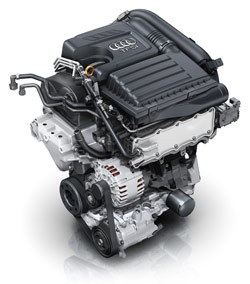 Engines available at the first drive event this next month will include a totally revamped 121-horsepower 1.4-liter TFSI four-cylinder gas engine (right), plus an upgraded 177-hp 1.8-liter. Diesel engines – or TDI units – will start with just the 148 hp and 236 pound-feet of torque in the latest 2.0-liter TDI. Later, with the launch of the five-door Sportback, a new 2.0-liter TFSI gas engine joins the group in the next S3, and an ultra-efficient 1.6-liter TDI. In the future, the 2.5-liter TFSI five-cylinder will go into an RS3, which the U.S. should eventually get in the four-door body.
Engines available at the first drive event this next month will include a totally revamped 121-horsepower 1.4-liter TFSI four-cylinder gas engine (right), plus an upgraded 177-hp 1.8-liter. Diesel engines – or TDI units – will start with just the 148 hp and 236 pound-feet of torque in the latest 2.0-liter TDI. Later, with the launch of the five-door Sportback, a new 2.0-liter TFSI gas engine joins the group in the next S3, and an ultra-efficient 1.6-liter TDI. In the future, the 2.5-liter TFSI five-cylinder will go into an RS3, which the U.S. should eventually get in the four-door body.
Besides that distant RS3, the U.S. will start out in later 2013 with both the 1.8- and 2.0-liter TFSI powerplants, which have been made lighter and more efficient than they are today. In addition, we will continue to get the 2.0-liter TDI, most likely in both the Sportback and sedan configurations. All of our future A3s will come with a newly developed multi-link rear axle, whereas any engine trims below 134 hp (i.e. 100 kW) are set to have a solid rear axle.
A primary operative in this A3's development has been to lower the overall weight. In this regard, the 1.4-liter TFSI trim in particular drops a significant 176 pounds due in part to the new aluminum crankcase for the engine. All other engine versions of the lineup will drop at least 130 pounds versus the current models. Chassis-wise, the Audi spaceframe aluminum-steel construction now makes its way into the compact segment as well with much of the front end components being made in aluminum.
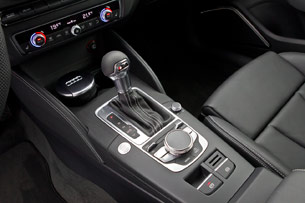
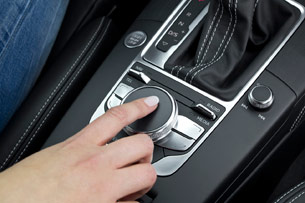
Practically every option available for the big A6, A7 and A8 will now be available on the wee A3, including a much better new compact design for the Audi MMI interface with MMI Touch integrated onto the top of the mouse-rheostat on the console. We tried this and it finally works really well. All safety and convenience systems will also trickle down into the MMI system with each of them able to be calibrated differently instead of adopting a single default threshold. Sounds like added complexity, but this new Audi Connect setup makes sense quickly. Audi's front pre-sense technology is also seen here, with the car being able to halt itself while traveling at slower speeds if it senses no reaction from the driver when a collision is imminent.
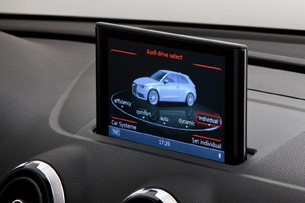
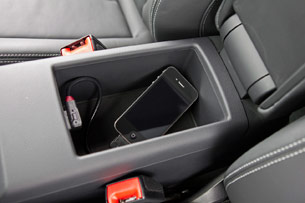
All onboard connectivity systems are no longer Windows based, but use a QNX proprietary system developed with German group Harman Becker, the logic being to avoid viruses and other security risks from the outside. And the latest pop-up MMI screen's thickness is now down to 11 millimeters – about the width of a smart phone. Speaking of Bluetooth connectivity, there will no longer be a cable needed to access everything on your phone. You'll just place the phone in the Audi console phone box and all is executed via a near-field planar system.
Audi intends to redefine the compact premium segment with the new A3 and it sort of needs to approach things with such ambition, seeing as the premium hatch segment is soon to be chock full of heady competition. It's just sort of a shame that we need to wait this long to get our A3s.
Our first drive of the three-door premium hatchback model that will be available at launch happens later this month, though it's sort of a shame we won't be getting this three-door here in the States. The five-door Sportback model that will be sold in the U.S. will be shown this October at the Paris Motor Show and will be available in Western European in January of next year. The premium hatch segment is fillling up fast now with this Audi, then the Volvo V40, to be followed then by the all-new Mercedes-Benz A-Class.
This completely new version of the A3 – now in its third generation having sold 2.7 million units worldwide since 1996 – is using the new VW Group MQB architecture, or "tranverse modular system" platform. Audi is finally in a position to make the A3/S3 a much larger sales volume car thanks to this universal architecture. Up until now, the various engine setups sharing the existing compact architecture required many variations, particularly in the forward or backward angle of incline of its transverse gas and diesel engines. With this new design, all engines will be inclined rearward at 12 degrees, which leans it naturally more toward the exhaust side facing the bulkhead, and helps reduce front overhang by two inches while creating more front passenger legroom as the front axle can move forward now by 1.6 inches.
 Engines available at the first drive event this next month will include a totally revamped 121-horsepower 1.4-liter TFSI four-cylinder gas engine (right), plus an upgraded 177-hp 1.8-liter. Diesel engines – or TDI units – will start with just the 148 hp and 236 pound-feet of torque in the latest 2.0-liter TDI. Later, with the launch of the five-door Sportback, a new 2.0-liter TFSI gas engine joins the group in the next S3, and an ultra-efficient 1.6-liter TDI. In the future, the 2.5-liter TFSI five-cylinder will go into an RS3, which the U.S. should eventually get in the four-door body.
Engines available at the first drive event this next month will include a totally revamped 121-horsepower 1.4-liter TFSI four-cylinder gas engine (right), plus an upgraded 177-hp 1.8-liter. Diesel engines – or TDI units – will start with just the 148 hp and 236 pound-feet of torque in the latest 2.0-liter TDI. Later, with the launch of the five-door Sportback, a new 2.0-liter TFSI gas engine joins the group in the next S3, and an ultra-efficient 1.6-liter TDI. In the future, the 2.5-liter TFSI five-cylinder will go into an RS3, which the U.S. should eventually get in the four-door body.
Besides that distant RS3, the U.S. will start out in later 2013 with both the 1.8- and 2.0-liter TFSI powerplants, which have been made lighter and more efficient than they are today. In addition, we will continue to get the 2.0-liter TDI, most likely in both the Sportback and sedan configurations. All of our future A3s will come with a newly developed multi-link rear axle, whereas any engine trims below 134 hp (i.e. 100 kW) are set to have a solid rear axle.
A primary operative in this A3's development has been to lower the overall weight. In this regard, the 1.4-liter TFSI trim in particular drops a significant 176 pounds due in part to the new aluminum crankcase for the engine. All other engine versions of the lineup will drop at least 130 pounds versus the current models. Chassis-wise, the Audi spaceframe aluminum-steel construction now makes its way into the compact segment as well with much of the front end components being made in aluminum.


Practically every option available for the big A6, A7 and A8 will now be available on the wee A3, including a much better new compact design for the Audi MMI interface with MMI Touch integrated onto the top of the mouse-rheostat on the console. We tried this and it finally works really well. All safety and convenience systems will also trickle down into the MMI system with each of them able to be calibrated differently instead of adopting a single default threshold. Sounds like added complexity, but this new Audi Connect setup makes sense quickly. Audi's front pre-sense technology is also seen here, with the car being able to halt itself while traveling at slower speeds if it senses no reaction from the driver when a collision is imminent.


All onboard connectivity systems are no longer Windows based, but use a QNX proprietary system developed with German group Harman Becker, the logic being to avoid viruses and other security risks from the outside. And the latest pop-up MMI screen's thickness is now down to 11 millimeters – about the width of a smart phone. Speaking of Bluetooth connectivity, there will no longer be a cable needed to access everything on your phone. You'll just place the phone in the Audi console phone box and all is executed via a near-field planar system.
Audi intends to redefine the compact premium segment with the new A3 and it sort of needs to approach things with such ambition, seeing as the premium hatch segment is soon to be chock full of heady competition. It's just sort of a shame that we need to wait this long to get our A3s.









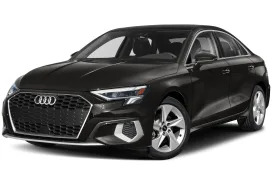
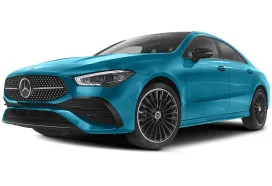
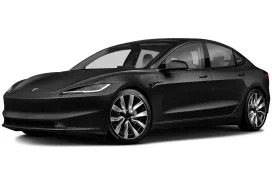

Sign in to post
Please sign in to leave a comment.
Continue